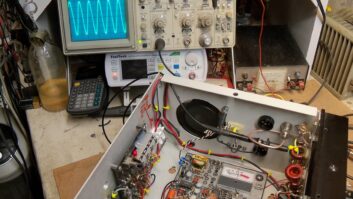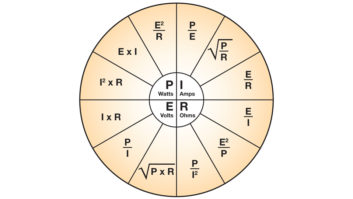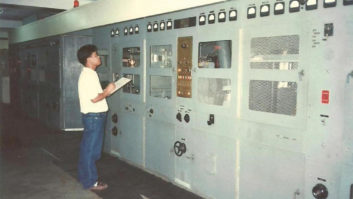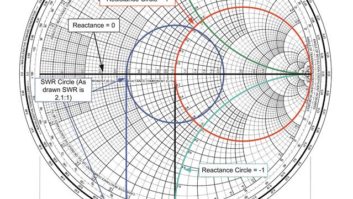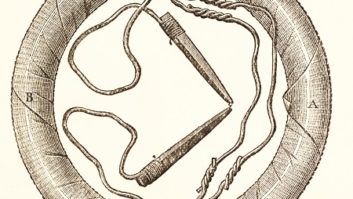
Georg Simon Ohm
This story has been edited to correct the original, which incorrectly stated that Pieter van Musschenbroek was from Lieden, Germany. He was from Leiden, Holland.
In 1827, a German physicist and mathematician published a scientific paper in which he put forth the principle that voltage, current and resistance in an electrical circuit were interrelated. When the value of one changed, he said, the others would change, and in a predictable way.
The paper included a formula that described those interactions. The equation is fundamental to the understanding of the way electrical circuits work. The physicist was Georg Ohm, and his seminal formula is known all over the world.
Ohm’s Law says that when resistance in a circuit is unchanged, voltage varies in direct proportion to current. The formula is written as E=IR. This simple mathematical statement was an amazing addition to the knowledge of electronics and is one that engineers learn at the beginning of their careers.
More importantly, it led to a whole slew of electrical “laws” and formulas that, together, determine how every piece of equipment broadcasters use is designed and operates.
LIGHTNING IN A BOTTLE
Ohm worked out his law when the knowledge of electrical force itself was not yet 100 years old. The Greeks knew and wrote about “static” electricity a few thousand years before Ohm and even named the electron, which means “amber” in Greek, a common source of static electricity; but it was not until the 1700s that experimenters began to work out the properties of electrical force.
As we learned in grade school, Benjamin Franklin speculated that lightning might in fact be electricity and wrote extensively about the subject in the early part of the 18th century. But it was not until 1752 that he got up enough courage to hoist his kite into a thunderstorm to prove it, by capturing the electrical discharge from a nearby strike in a glass bottle.
The bottle was called a Leyden Jar, named by one of its inventors, Pieter van Musschenbroek, in honor of his hometown of Leiden, Holland. Franklin’s experiment, fortuitously performed with a Leyden Jar rather than something that might have been called a Musschenbroek Bottle, is the origin of the saying that having a great idea is like having “lightning in a bottle.”
Ohm and others like him, lacking Franklin’s sense of adventure, waited for a more controllable and less deadly source of electricity, and were rewarded by the experiments of two Italian scientists: Luigi Galvani and Alessandro Volta (the latter being the namesake of the unit of electric potential; the “volt” in Ohm’s formula).
These men found that stacking alternating sheets of copper and zinc between an acidic solution created a sustainable electrical force. Originally these were called the Galvanic cell and the Voltaic pile. The names of the two devices, sounding a bit sinister perhaps, soon changed to batteries.
As Ohm knew, a wire connected between the two different plates of one of Volta’s batteries would cause current to flow. He also found that increasing the length of the wire decreased the current. He had discovered electrical resistance. The exact relationship between voltage current and resistance was not understood and that is what Ohm worked out.
By the time he got around to it, though, Volta’s name had already been tapped as the unit of EMF, or Electromotive Force, another name for electrical potential. That is why voltage is abbreviated with an “E” in electrical formulas.
The unit for current was similarly named for Andre-Marie Ampere, a French scientist, so that only left resistance for Ohm, and that is what he got. The “Ohm” is the standard unit of electrical resistance, and is technically defined as the result obtained when one volt of electrical force causes one ampere of current to flow in a circuit.
Much later Ohm was honored again when the people who name these things (who are those guys?) gathered together to assign an appropriate Nom de Plume to the unit of electrical conductance. It being the exact reverse of resistance, they named it that: The Mho. Must have been Opposite Day.
KEEPING IT SIMPLE
The most elegant aspect of Ohm’s Law is its simplicity. If two of the variable quantities are known, the formula can be used to find the third. I learned the law using a simple circle graphic.
By covering up the unknown parameter, you can immediately see how to use the other two to find the missing one. Covering the voltage term E leaves IR on the bottom of the circle. The value for E is found by multiplying those two variables.
If a circuit has three amperes of current I flowing through 300 ohms of resistance R, the applied voltage E equals 3 x 300, or 900 volts. Using the same numbers, if the voltage and current are known, covering up I leaves E over R. Dividing E of 900 volts by R of 300 ohms gives the answer of I=3 amperes. And you don’t have to be smarter than a fifth grader.
Ohm’s Law led to a derivative, which substitutes P for power in the top half of the circle and replaces the R in the circle with the voltage term E. Power is measured in watts, named for James Watt, the Scottish inventor of the first practical steam engine.
Watt was not an electrical engineer or scientist, but made such extensive calculations of power — and in the process coined the term “horsepower” — that the unit of electrical power was named after him, again by those mysterious guys who do that sort of thing. In any event, the formula in that iteration works exactly the same as the original.
IN PRACTICE IT’S PERFECT
Both formulas are practical in ways that might not be immediately apparent and can be used to diagnose many problems that broadcast engineers routinely run into. For example, why does a power supply blow a fuse?
If we can assume that the power company has not inadvertently throttled up the grid and sent your studio 220 volts instead of the normal 110, then according to Ohm’s Law, there can be only one reason: The internal resistance of the power supply or its associated circuits has gone down, because the law tells us that when resistance goes down, current goes up.
It follows that if the resistance goes low enough, the current will go high enough to blow the fuse. And here’s the thing: it doesn’t even have to be a dead short (meaning no resistance at all).Ohm’s Law can tell you precisely how low the resistance has to go before the current flow will exceed the rating of the fuse.
Valuable information when something needs fixing fast.
Using the power variation of the formula can help diagnose transmitter problems, or just to confirm normal operation. If you know your transmitter’s operating efficiency (either tube-type or solid-state) and the output power is 5,000 watts, you can figure out how much current should be coming from the power supply, provided you know the supply voltage.
If the supply voltage is 50 volts (not uncommon in a solid-state transmitter) and the transmitter efficiency is 90 percent, the power supply current has to be 111 amps, if all is well. The calculation is 5,555 watts (the power needed for the transmitter to make 5,000 watts of RF assuming 90 percent efficiency), divided by 50 volts, which equals 111 amps.
If the power supply current meter is reading significantly higher or lower than that, something is wrong.
Similarly, in a tube-type transmitter, if a current overload relay intermittently trips, Ohm’s Law tells us that the resistance of the circuit being protected by the relay has decreased, or the supply voltage has increased. According to Ohm’s Law, when current increases there can only be one of two reasons: Either the voltage has increased (entirely possible in a transmitter circuit) or the internal resistance has decreased.
Knowing the formula makes all the difference in diagnosing and finding the problem.
Georg Ohm died in 1854, 48 years before Marconi astounded the world by broadcasting a signal across the Atlantic and setting the stage for the future of radio. But Marconi and all who have followed him would have gotten nowhere without Ohm’s Law. It’s the true Formula One.
Jim Withers is owner of KYRK(FM) in Corpus Christi, Texas, and a longtime RW contributor. He has four decades of broadcast engineering experience at radio and television stations around the country.





